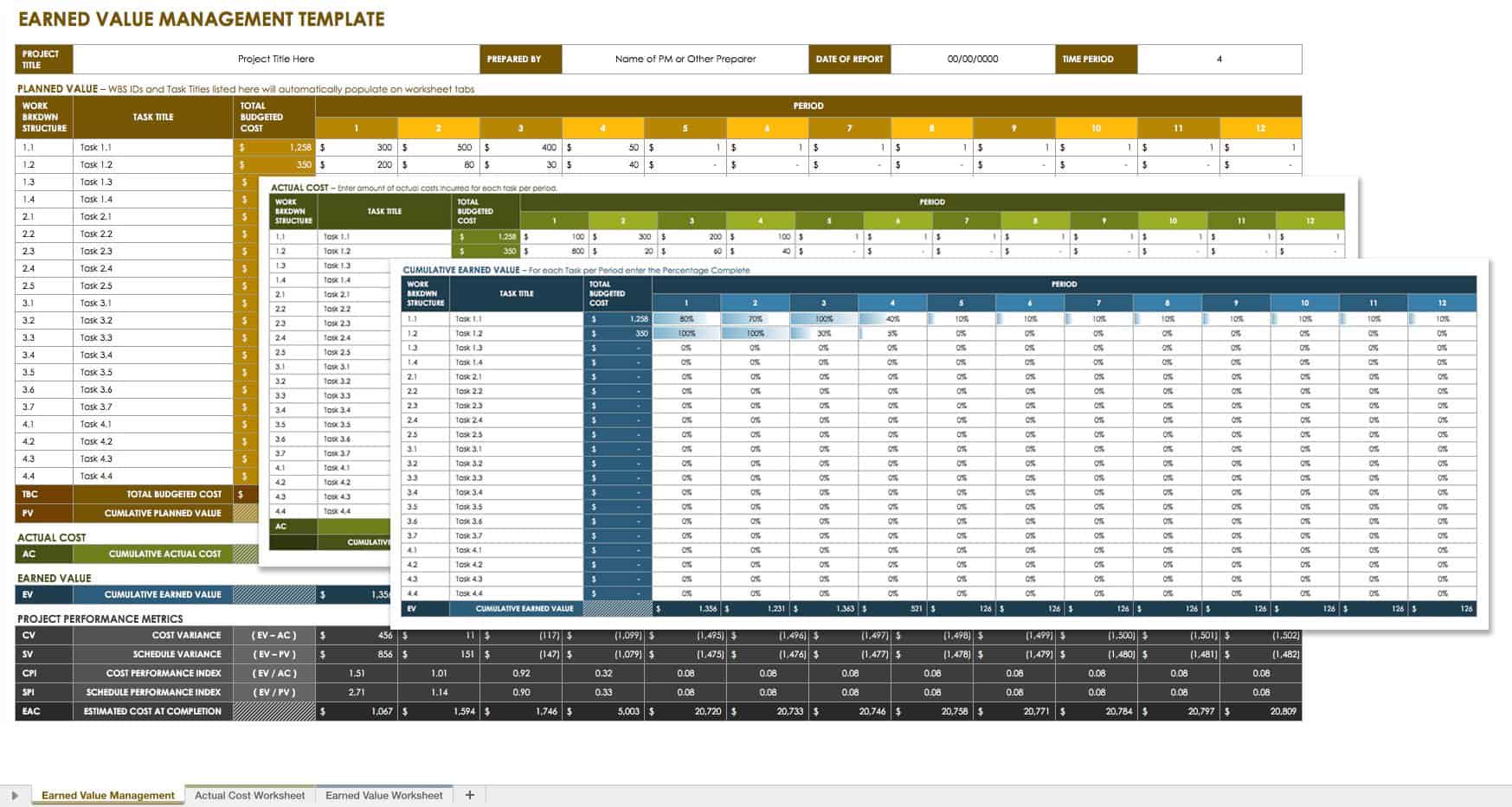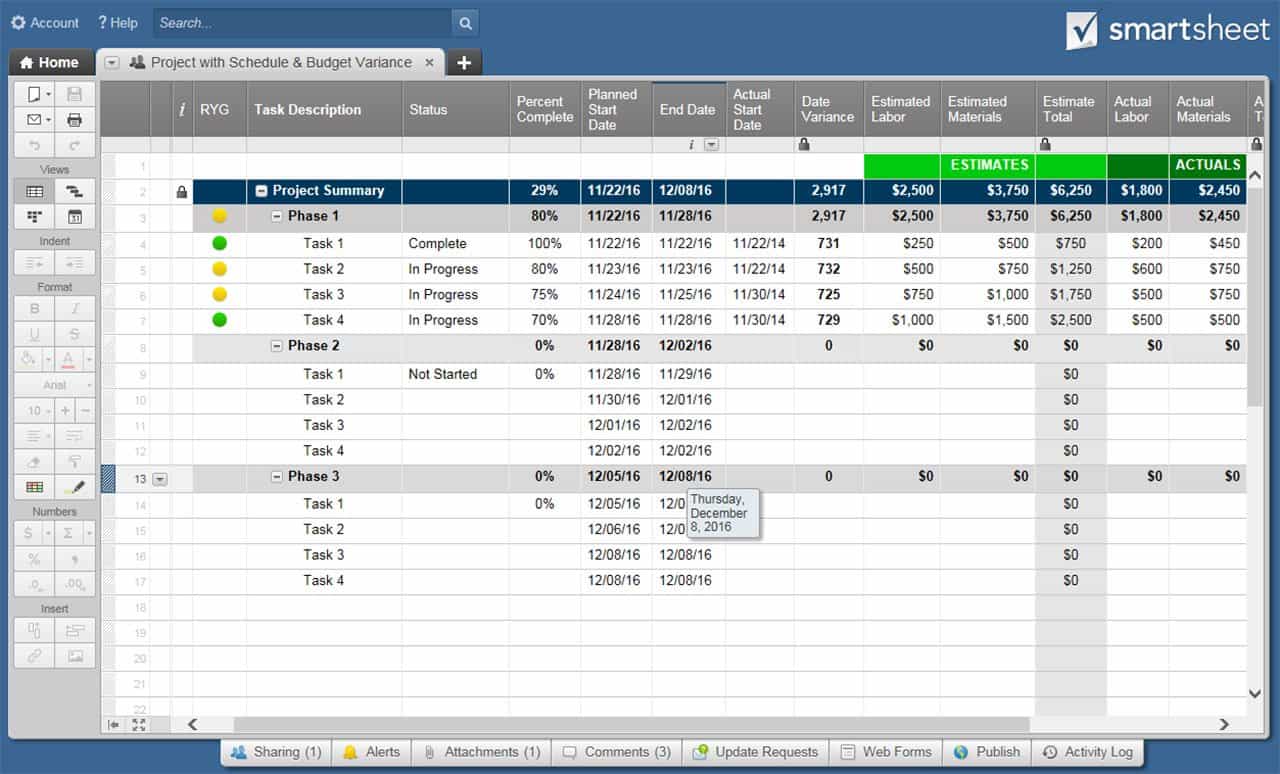What Is Earned Value Management?
Earned value management is a project management technique used to assess cost and schedule performance, and to gauge a project’s progress. It is based on assigning value to each project activity, according to the budgeted costs of those activities. Successful completion of these activities equals a portion of the project’s value earned, so earned value serves as a measure of overall project progress.
Large proportions — even majorities — of projects in certain sectors suffer from cost overruns. For example, Oxford University’s Professor Bent Flyvbjerg and his colleagues found that nine out of 10 mega projects across 20 countries experienced cost overruns, with actual costs being, on average, 28 percent higher than approved costs.
Most cost overruns don’t occur as large, egregious failings or major accidents. Instead, as Chris Ronak writes for ProjectTimes.com, they’re typically the result of incremental overruns that occur throughout project execution. These are largely unavoidable, but they can eventually spiral out of control and cause major cost overruns. EVM took hold as a way to help control sprawling defense projects and can help prevent these issues.
How Earned Value Management Works
Earned value management is based on the concepts of planned value, earned value, and actual cost, and its main advantage is that it allows you to compare progress and performance in a way that a simple cost comparison doesn’t. First, here’s an example to illustrate the concept of EVM.
Suppose that work is under way on a project scheduled to last 30 days with a budget of $30,000. If the project manager reports on day 20 that $20,000 of the budget has been spent, it’s tempting to assume that the project is perfectly on track.
Assuming the project is on schedule can be misleading. The project may actually only be halfway complete, and two-thirds of the budget has been spent on completing only half the work. Further, since only half the work is complete but over half of the scheduled work days have elapsed, it’s likely that the project will either require overtime (to meet its deadline) or an extension. Of course, the reverse could also be true: a project might cost less than expected or be completed before deadline.
In earned value management, each portion of scheduled project work is assigned a fraction of the budget based on the proportion of the total work it represents. This is called the planned value, and is typically cumulative. Building on the previous example, suppose that the work scheduled to be completed after 15 days is considered to represent 50 percent of the project work and is thus assigned a planned value of $15,000. On day 15, the planned value may be compared to the earned value, which is the value of the work actually completed. If the planned and earned values are equal, the project is on schedule. If the planned value is greater than the earned amount, the project is behind schedule; if it’s less than the earned amount, the project is ahead of schedule. This comparison gives the project manager and stakeholders a clear idea of how the project is progressing in relation to the schedule.
Another important metric is the actual cost, which is the total sum of money expended at a certain time in the schedule. For example, on day 15 the planned and earned values may be equal (each at $15,000), indicating that the project is proceeding according to schedule. However, the actual cost may be higher - for example, $20,000 - showing that the project is on schedule but over budget.
This exercise, called earned value analysis, is the most comprehensive trend analysis technique available to project managers, since it integrates scope, time, and cost aspects of performance. Used in real time, earned value management is an extremely effective method for forecasting performance.
The History of Earned Value Management
The concept we now know as earned value management originated in industrial manufacturing in the early 20th century with the work of husband-and-wife management theorists Frank and Lillian Gilbreth. However, its major use breakthrough can be traced to U.S. government programs of the 1960s, when an earned value management concept called PERT/COST was introduced.
In 1967, in response to cost and schedule overruns that plagued their acquisitions, the U.S. Department of Defense began implementing an approach called the Cost/Schedule Control Systems Criteria (C/SCSC) via DoD Instruction 7000.2, “Performance Measures on Selected Acquisitions.” This was a criterion-based approach comprising 35 management standards that attempted to track cost and schedule performance in large defense programs. This early C/SCSC system was not so much a management methodology as a set of standards for contractors’ planning, budgeting, and financial analysis — in essence, a complex financial control tool. Its objectives, however, were similar to those of earned value management today — proper planning, establishing baselines to gauge performance by, regular performance analysis, and taking corrective action as necessary.
In the late 1980s and early 1990s, as researcher Tae H. Lee wrote, the DoD’s interest in program schedule and cost performance grew as the national defense budget declined. Additionally, public interest was piqued by problems arising in major programs such as the Navy’s A-12 Avenger II, which was terminated in 1991 because of problems detected by earned-value performance analyses. By this time, earned value management was a popular project management concept that project managers and their bosses could use.
In 1997, NASA established the earned value management requirements to apply to NASA contracts. A year later, in 1998, the government discarded the C/SCSC system in favor of more flexible earned value management systems, and ownership of the earned value management criteria — of which there were now 32 — was passed to the industry with the adoption of the ANSI EIA 748-A standard.
A number of other U.S. government agencies, including the Department of Energy, the Department of Homeland Security, the Department of Transportation, and the Federal Aviation Administration now mandate earned value management. England, Canada, Australia, China, and Japan also employ earned value management methodologies.
Outside of the U.S. government, early adopters of earned value management include the architecture, engineering, and construction industries. The Sarbanes-Oxley Act of 2002, which set new requirements for U.S. public company executives that included accurate disclosures of project statuses and final costs, also contributed to the adoption of earned value management as a way to help meet these new disclosure requirements.
Objectives and Benefits of Earned Value Management
Effective earned value management is centered on a few objectives that are met in series.
- Relate time-phased budgets with a comprehensive breakdown of project work: Since the basic concept of earned value management is assigning value to work, the first step is to associate scheduled activities with portions of the budget. To do this, the work must be defined as elements through the use of a work breakdown structure. The fundamental element of a work breakdown structure is a task, and you must associate each task with a portion of the project budget.
- Create a project baseline to evaluate progress and cost performance: Once value has been assigned to all of a project’s work elements, you can use the schedule and budget to create a project baseline. The project baseline is a representation of how a project’s budget is expected to be spent as the project progresses — in other words, how planned value is expected to be earned. It is created through schedule network analyses such as the critical path method, which identifies dependencies among tasks and calculates the expected total duration of a project. Once execution is under way, you may compare this planned value to the earned value to gauge progress, and the in turn compare the earned value to the actual cost to gauge cost performance.
- Provide valid, timely data to enable proactive project management: Project tracking (comparing actual progress and performance to the project baseline) is particularly useful when done via graphs. These visual representations not only make it easy to track progress and cost performance historically, but also to forecast whether progress and cost performance objectives are due to be met.
One of EVM’s strengths is the ease with which progress and cost performance data can be collected, communicated, and used to forecast future progress and cost performance. Because earned value management metrics are straightforward to understand, executives have an easier time making high-level decisions when it becomes clear a project will not meet its cost and schedule goals. It’s normal to see small variations between the project baseline, earned value, and actual costs, but large variations may indicate that the project is heading for overruns, and managers will want to employ corrective measures where possible.
Benefits of Earned Value for Contractors and Customers
Earned value management’s ease of use and ability to integrate scope, schedule, and cost aspects make it a valuable methodology for contractors and customers alike. For customers, most of the EVM benefits come from the increased real-time visibility into project progress and performance.
Earned value management facilitates communication and can improve confidence in a contractor’s ability to manage a project. Creating progress and performance forecasts allows customers to conduct profitability analyses that enable them to cut their losses and pull the plug on projects where necessary (as has happened with defense projects in the past). Performance tracking via project baselines provide objective, real-time indicators of how a project is proceeding, which means that you can identify problems early and take corrective or preventative actions if necessary.
For contractors, there are several payoffs for extensive planning and the effort that goes into constructing cost and schedule baselines. Among them is a greater ability to manage and respond to problems and to meet cost and schedule requirements, which in turn translate to increased customer confidence. As with customers, accurate real-time data helps contractors tackle problems proactively and mitigate their effects.
Contractors reap two additional benefits by employing earned value management methodologies. First, the emphasis on planning and scheduling can improve addressing risk factors during the planning stage. This increases the likelihood that a project will meet its cost and schedule requirements, since you identify a larger number of risks that you can effectively pre-empt or account for. Secondly, earned value management methodologies can help project managers navigate the so-called triple constraints (time, cost, and scope) more effectively. Earned value management is based on the integration of these three aspects of project work: a project’s schedule and cost baselines are constructed with a well-defined project scope in mind. This serves as a check on scope creep — changes in scope without complementary changes in allocated budgets and scheduling — since earned value management dictates that all elements of work must have an assigned value.
Earned Value: Key Metrics, and Concepts
Earned value management works through a series of easily understandable values and metrics. Let’s see what these are and how they work. Here’s a template to help you put these concepts to work.
Download Earned Value Management Template
Budget At Completion (BAC): The expected total cost of completing a project, which is established during the planning phase by assigning costs to each element of a work breakdown structure.
Planned Value (PV), or the Budgeted Cost of Work Scheduled (BCWS): At any point in a project, the planned value is the portion of the budget allocated to project work scheduled to be completed by that date. The planned value is the baseline to which earned value is compared to indicate how much of the scheduled work has actually been completed.
Calculate planned value using the formula:
Planned value (PV) = percent of work scheduled for completion (percent planned) X budget at completion (BAC)
or simply
PV = percent planned X BAC
Here’s how planned value works. Let’s say you have a project scheduled to last 100 days, with one percent of the project due to be completed each day. The total budget assigned to the project — the budget at completion (BAC) — is $100,000. What is the planned value on day 40?
We know that 40 percent of the total work is due to be completed on day 40, so:
PV = 0.40 X $100,000 = $40,000
Earned Value (EV), or the Budgeted Cost of Work Performed (BCWP): At any point during a project, the earned value is the portion of the budget allocated to work actually completed by that date. Remember, the planned value is the budget allocated to work scheduled to be finished; the earned value is the budget allocated to the work actually completed.
Calculate earned value using the formula:
Earned value (EV) = % of work actually completed (% complete) X budget at completion (BAC)
or simply
EV = % complete X BAC
In the previous example, we assumed that 40 percent of a 100-day project with a budget of $100,000 dollars would be completed by day 40. However, the project manager knows only 30 percent of the project has actually been finished. Therefore:
EV = 0.30 X BAC = $30,000
By comparing the planned and earned values, we see that the project is $10,000 dollars short of its planned value on day 40. The project is running significantly behind.
Actual Cost (AC), or the Actual Cost of Work Performed (ACWP): The cumulative amount of money spent at a particular point in a project. Actual cost isn’t usually calculated via formula.
Let’s look again at the example of our 100-day, $100,000 project which is only 30 percent complete on day 40. We know the project is running behind schedule, but how is it performing cost-wise on day 40?
The earned value on day 40 is $30,000, which means that we’d expect about $30,000 to have been spent thus far. However, the project manager and accountant sit down and determine that actual costs total $25,000 — less than the scheduled amount. So while this project is running behind schedule, it is also running under budget, as the actual cost of work performed demonstrates.
Estimate At Completion (EAC): As a project is under way, the estimate at completion is a forecast of the total amount of money needed to complete the project. The EAC is computed using another value: the estimate to complete (ETC), which is the anticipated total cost of completing all remaining work.
You can calculate the ETC in a number of ways, depending on whether future spending is expected to go according to plan or if it will be adjusted (based on observed spending thus-far). For the former, calculate ETC using this formula:
ETC = BAC – EV
The EAC is computed as the total cost of the work already done (the actual cost) and the estimate to complete.
EAC = AC + ETC
To return to our 100-day, $100,000 project, which is 30 percent complete on day 40, we first compute the ETC:
ETC = 100,000 – 30,000 = $70,000
Next, we use the ETC and the AC to compute the EAC:
EAC = 70,000 + 25,000 = $95,000.
As such, the project is estimated to be completed for a total cost of $95,000 — $5,000 less than planned.
This difference between the BAC and the EAC is called the variance at completion (VAC). For our project:
VAC = 100,000 – 95,000 = $5,000
Dealing with Variances in Earned Value Management
These values and metrics form the basis of some key concepts in earned value program management. Here are the details.
Cost variance: Cost variance is the difference between the budgeted value of work completed at a point in time (the earned value to that point) and the actual cost of completing that work. It’s calculated using the formula:
Cost variance (CV) = EV – AC
A positive cost variance indicates that a project is running under budget (called an underrun); a negative cost variance indicates a project is over budget (an overrun).
For example, the cost variance in our 100-day, $100,000 project at day 40, which is under-running its budget, is equal to:
CV = 30,000 – 25,000 = 5,000
A related statistic is the cost performance index (CPI), or the ratio of earned value to actual cost:
CPI = EV/AC
A cost performance index higher than 1.0 indicates that the project is costing less than expected; one that’s less than 1.0 indicates a project that’s costing more than expected.
For example, the cost performance index for our 100, $100,000 project at day 40, which is under-running its budget, is equal to:
CPI = 30,000/25,000 = 1.2
You can use the CPI to compile a value called the burn rate, which measures whether a project is on track to be completed within budget. It is calculated by the formula:
Burn rate = 1/CPI
A burn rate greater than 1.0 indicates that a project is exhausting its budget faster than planned; a burn rate less than 1.0 indicates that the budget is not being exhausted as quickly as planned.
For our example project with a CPI of 1.2 (which you’ll remember is a good thing — probably) the burn rate is:
Burn rate = 1/1.2 = 0.83
Schedule variance: The difference between the value of work expected to be completed by a given point in time and the value of the work actually finished at that point in time. It’s calculated by the formula:
Schedule variance (SV) = EV – PV
A positive schedule variance means the project is ahead of schedule; a negative schedule variance indicates the project is behind schedule.
Here’s a project template with cost and schedule variances.
Project with Schedule and Budget Variance
To learn more about calculating scheduling variances, read Hacking the PMP: How to Calculate Schedule Variance.
The schedule variance in our 100-day, $100,000 project at day 40, which is behind schedule, is equal to:
SV = EV – PV = –$10,000
It’s also possible to compute a schedule performance index (SPI), which is the ratio of earned value to planned value, using this formula:
Schedule performance index (SPI) = EV/PV
A schedule performance index higher than 1.0 indicates that the project is ahead of schedule; one that’s below 1.0 indicates that it’s running behind schedule.
For example, the schedule performance index for our 100-day, $100,000 project at day 40, which is running behind schedule, is equal to:
SPI = 30,000/40,000 = 0.75
There is, however, a problem with the SPI. At the end of any successfully completed project, the earned value will always be equal to the planned value. This means that the SPI will be equal to 1.0, even if the project was completed months behind schedule. So, the SPI at the end of a project will likely misrepresent a project’s actual schedule performance.
You can address this problem by using the concept of earned schedule. The earned schedule is an extension of traditional earned value management that involves comparing when work was supposed to be completed to when it was actually completed.
Earned schedule computes schedule variance differently than traditional earned value management: in units of time, rather than units of budget. As such, it introduces a few new terms:
- Earned schedule (ES) is the time at which a progress point was expected to have been reached.
- Actual time (AT) is the time at which the progress point was actually reached.
According to earned schedule, compute schedule variance by using the formula:
SVt = ES – AT
Referring back to our 100 day, $100,000 project, let’s assume that work scheduled to be completed on day 40 was actually completed on day 54.
SVt = 40 – 54 = –14 days
The schedule performance index is calculated using the formula:
SPIt = ES/AT
For our project:
SPIt = 40/54 = 0.74
You can also use these values to forecast the time required to complete the project using the formula:
Time estimated at completion = AT + planned duration of work remaining (PDWR)
Like the estimate to complete (ETC), you may calculate the PDWR in a number of ways depending on performance patterns that the rest of the project is expected to adhere to.
Implementing Earned Value Management
Though large projects typically incorporate all aspects of earned value management — that is, examining progress with scope, time, and cost requirements in mind — there are also a few lightweight applications that may be appropriate for smaller or more informal projects where cost and schedule requirements are not vital. These can be broadly classified as simple, intermediate, and advanced implementations.
Some organizations decide the extent of earned value implementations for projects by using threshold values. Others scale earned value implementations according to both the specifications of the project at hand and the skill of the project manager and project team.
- Simple Implementations: Simple implementations of earned value management neither prepare a project baseline to assess performance on, nor take actual costs into consideration. Instead, they simply define a project as a series of tasks, assign value to each task, and then track the project’s earned value progress without regard to a baseline. While implementations are limited in their usefulness, they may be appropriate for repeatable projects with low cost variance, such as car construction, to compare and contrast the rates at which value is earned.
- Intermediate Implementations: Intermediate implementations of earned value management take a project baseline into account. Use intermediate implementation for projects where time to completion is a concern. Intermediate implementations not only involve assigning value to work, but also using schedule network analyses and schedule models to identify how long a project is expected to take and to create a baseline. In intermediate implementations, earned value is compared with a planned value baseline to identify schedule variance.
- Advanced Implementations: The full spectrum of earned value management concepts we’ve discussed are brought to bear in advanced implementations, which incorporate earned value tracking, project baselines, and actual costs to compare both progress and cost and schedule performance.
The Limitations of Earned Value Management
Although earned value management may be implemented to varying degrees, there are limitations on the types of projects that it suits. For example, earned value management depends on the ability to assign value to discrete work packages, which calls for a well-defined project scope. This makes it unsuitable for projects where the scope is undefined when project execution begins, such as discovery-driven, software development, or research-based projects. In these types of projects, the scope of the work only becomes apparent as the project team executes.
Moreover, in projects where work is not directly associated with specific work breakdown structure components, it is difficult to accurately track earned value because much of the effort involved with the project has no defined completion date.
Other limitations come from the ease and speed at which the metrics can be computed. For example, smaller projects may not have dedicated project accountants, so actual costs are not easily computed. Likewise, the preparation of a project baseline, which requires some skill, may not be possible.
There is also the problem of ensuring that data being fed into an earned value management system is actually up to date. Earned value management is prized for its ability to provide data that facilitates proactive decision making and corrective measures, but its ability to do so is undermined if there’s a lag between the time that work is completed and when costs are invoiced.
Finally, the level of detail in earned value calculations is constrained by the level of detail in the terminal elements of the work breakdown structure and the length of the reporting period. If the earned value is not sufficiently detailed, small but significant variances in cost and schedule become much easier to miss.
Moreover, to employ earned value management successfully, project managers need to use current data to compute earned value and actual costs.
Common Standards for Earned Value Management
We’ve already seen how important it is for earned value management data to be timely, accurate, and reliable. But data must also be auditable, since earned value management helps facilitate transparency in communications between customers and contractors.
The authority reference on earned value management is a set of 32 guidelines applicable to earned value management on Department of Defense projects in the EIA-748 Standard for Earned Value Management Systems. These guidelines are divided into five main sections encompassing different categories of standards.
- Organization: The section comprises five guidelines that deal mainly with the establishment and integration of a work breakdown structure and a program organizational structure. The work breakdown structure details the work involved to successfully complete a project, and the program organizational structure identifies the people responsible for completing work elements. Organization also involves ensuring that the planning, scheduling, budgeting, work authorization, and cost accumulation processes are fully integrated - with each other, with the work breakdown structure, and with the program organizational structure.
- Planning, Scheduling, and Budgeting: This section comprises 10 guidelines on using the program budget, work breakdown structure, and schedule network analysis to determine the planned value and create a project baseline. One important aspect details how to assign earned value when work packages are considered complete. We know that work only begins when authorized, but when is it considered complete? Depending on the type of project, managers may assign earned value based on full completion, partial completion, at the start and end of a work package, or in a variety of other ways.
- Accounting Considerations: This section, comprising six guidelines, deals with how to capture, report, and incorporate actual costs into earned value management.
- Analysis and Management Reports: This section, also comprising six guidelines, draws attention to how to conduct, report, and act upon earned value analyses. It involves establishing a schedule for examining variances and defines how to report these variances to management, who may choose to act. It also states the need to revise estimates as the project is executed.
- Revisions and Data Maintenance: This last section, comprising five guidelines, concerns the steps involved with baseline control and modification upon customer request. It stresses ensuring that authorized changes to a project are reflected in changes to the budget and the schedule. These guidelines serve to counteract scope creep.
The Department of Defense Office of Performance Assessment and Root Cause Analyses is responsible, among other things, for overseeing and governing earned value management throughout the Pentagon. It ensures that earned value management in the DoD is in keeping with the EIA-748 guidelines.
All About Agile Earned Value Management
Earned value management for Agile projects presents a unique challenge, since Agile project management embraces scope change while traditional earned value management relies on a defined a project scope (and assigns value to elements of that scope). To reconcile this difference, Agile project management is a modified earned value management approach tailored for Agile project development. Here’s how it works.
Instead of assigning value to each of a project’s work elements, Agile project management uses a schedule with fixed time intervals. During each interval, the project team works to address a prioritized list of requirements (called user stories) while burning through the budget. Earned value and planned value are measured in units called story points, which indicate the relative sizes of work items.
Earned value for Agile projects is illustrated on a burn-down or burn-up chart, (named for the way the budget is burned through as work proceeds). As project execution proceeds, the budget is “burned down.”
The total planned value is illustrated as a line on the burndown chart (called the scope floor), which indicates the number of story points you plan to complete - you can adjust the scope floor up or down as scope requirements change. Plot the planned value over time on the chart as a line that approaches the scope floor.
Measure the remaining earned value, like the planned value over time, in story points - it also approaches the scope floor as the project is executed and the budget is burned through. By extrapolating the remaining earned value line to the point at which it meets the (current) scope floor, you can forecast the project’s end date.
The earned value is measured at the end of each iteration, and the number of story points earned in each iteration is recorded as the velocity. The concept of velocity is important in Agile projects because it allows managers to consider the real pace of earned value independently of changes to project scope, which may happen quite frequently.
Common EVM Mistakes and Advice from the Pros
Experts in earned value management praise its potential for keeping projects on track, but there are some common pitfalls. Here are some tips from leading specialists.
1. Don’t Wait to Get the EVM Team Involved in a Project
Alan Copsey, a EVM specialist at NASA’s Goddard Space Center, says successful implementation depends on early and frequent interaction between the EVM specialists and the project management team. He notes that often, the earned value management team is not brought on board until work breakdown structures and other items are already in place
2. Ensure Project Controllers Are Well-Trained in EVM
“Training and certification must be enforced and mandated for all project control and earned value management staff who manage and control integrated cost and schedule baselines across the United States federal government, state government, and local government projects and programs, and on all commercial projects to help identify and mitigate risks of cost overruns, schedule delays and poor quality on projects,” he adds.
3. Don’t Make EVM More Complicated Than it Needs to Be
Problems in implementation often stem from “methods and processes chosen by the project manager. EVPM can be implemented in a no-nonsense simple approach or it can be implemented in a complex and time-consuming manner. The implementation of EVPM is highly correlated to the project manager’s knowledge of EVPM.” Baber explains that inadequate knowledge can result in “a complex and internally inconsistent process that will not yield useful project indicators. A poorly implemented EVPM system will confuse and demoralize the project team … Project managers who accurately understand EVPM are able to implement a common-sense approach that is usable and understandable to all stakeholders.”
Darryl C. Shawgo, an EVM Specialist who works extensively on federal projects, agrees that making EVM more complex or rigorous than it needs to be is a common mistake.
4. Develop a Process for Quantifying Work
Read a discussion of level of effort in EVM by EVMS consultants Humphreys & Associates here.
Shawgo also stresses the need for shared commitment to EVM. “The single greatest thing you can do to ensure success on your EVM program is to make sure your team understands basic EVM principles and the process and tool in place for everyone (you, management, engineers, and people on the shop floor) to measure this progress easily and effectively so you can integration into your EVM baseline. It is imperative to make sure your team understands why you are asking them to do these things. Without their buy-in and understanding of why you are doing EVM, you will set up yourself and your team for failure,” he says.
“Training and certification must be enforced and mandated for all project control and earned value management staff who manage and control integrated cost and schedule baselines across the United States federal government, state government, and local government projects and programs, and on all commercial projects to help identify and mitigate risks of cost overruns, schedule delays and poor quality on projects,” he adds.
Additional Resources to Delve Deeper into EVM
There are some excellent resources available to dig into the fine points of earned value project management. As the authoritative guide on criteria for earned value management, the Electronic Industries Alliance’s EIA-748 for Earned Value Management Systems is required reading for all serious earned value management practitioners.
The official overseer for earned value management for the Department of Defense, the Office of Performance Assessment and Root Cause Analyses publishes an Earned Value Management System Interpretation Guide, an important supplement to EIA-748.
The Project Management Institute’s Practice Standard for Earned Value Management is a good resource for project managers looking to adopt earned value management practices.
In addition, the Defense Acquisition University’s Earned Value Management Gold Card explains common earned value management terminologies, lists the equations for calculating importance metrics, and provides a labeled sample earned value chart.
Better Manage Earned Value with Smartsheet Dashboards
The best marketing teams know the importance of effective campaign management, consistent creative operations, and powerful event logistics -- and Smartsheet helps you deliver on all three so you can be more effective and achieve more.
The Smartsheet platform makes it easy to plan, capture, manage, and report on work from anywhere, helping your team be more effective and get more done. Report on key metrics and get real-time visibility into work as it happens with roll-up reports, dashboards, and automated workflows built to keep your team connected and informed.
When teams have clarity into the work getting done, there’s no telling how much more they can accomplish in the same amount of time. Try Smartsheet for free, today.





